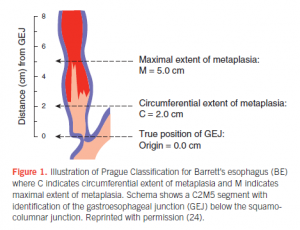 New ACG Guideline: Diagnosis & Management of Barrett’s Esophagus November 2015 AJG
New ACG Guideline: Diagnosis & Management of Barrett’s Esophagus November 2015 AJG
Nicholas J. Shaheen, MD, MPH, FACG; Gary W. Falk, MD, MS, FACG; Prasad G. Iyer, MD, MSc, FACG; and Lauren Gerson, MD, MSc, FACG
Barrett’s esophagus (BE) is among the most common conditions encountered by the gastroenterologist. In a new guideline published online November 3, 2015 in The American Journal of Gastroenterology, the American College of Gastroenterology updates its guidance for the best practices in caring for these patients and offers a pragmatic framework for diagnosis and management. The new guideline makes evidence-based recommendations on diagnosis, screening surveillance and therapy, including chemoprevention, endoscopic therapy, surgical therapy and management of Barrett’s esophagus after endoscopic therapy. The authors recommend that endoscopists who practice endoscopic ablative procedures should additionally offer endoscopic mucosal resection.
About Barrett’s Esophagus (BE)
Risk factors associated with the development of Barrett’s esophagus include long-standing gastroesophageal reflux, male gender, central obesity, and age over 50 years. The goal of a screening and surveillance program for BE is to identify individuals at risk for progression to esophageal adenocarcinoma, a malignancy that has been increasing in incidence since the 1970s.
Key Clinical Implications of the New ACG Barrett’s Esophagus Guideline
- These guidelines continue to endorse screening of high-risk patients for Barrett’s esophagus; however, routine screening is limited to men with reflux symptoms and multiple other risk factors.
- Acknowledging recent data on the low risk of malignant progression in patients with nondysplastic BE, endoscopic surveillance intervals are attenuated in this population; patients with nondysplastic BE should undergo endoscopic surveillance no more frequently than every 3–5 years.
- Neither routine use of biomarker panels nor advanced endoscopic imaging techniques (beyond high-definition endoscopy) is recommended at this time.
- Endoscopic ablative therapy is recommended for patients with BE and high-grade dysplasia, as well as T1a esophageal adenocarcinoma.
- Based on recent level 1 evidence, endoscopic ablative therapy is also recommended for patients with BE and low-grade dysplasia, although endoscopic surveillance continues to be an acceptable alternative.
- Given the relatively common recurrence of BE after ablation, we suggest postablation endoscopic surveillance intervals.
What’s New Here
These guidelines differ markedly from their predecessor in several areas. These include the expanded use of endoscopic ablative therapy, especially their extension to patients with low grade dysplasia, based on high-quality level 1 evidence demonstrating diminished risk of progression and/or adenocarcinoma after treatment. In addition, there is further refinement of screening recommendations, based on data demonstrating both a lower risk of esophageal adenocarcinoma in patients with nondysplastic Barrett’s esophagus and a better understanding of the impact of gender and anthropomorphics on risk. The most important of these changes is the recommendation that females with GERD symptoms no longer undergo routine screening. Finally, surveillance recommendations have been attenuated to recognize the relatively rare occurrence of progression in nondysplastic Barrett’s esophagus, as well as the unclear nature of benefit inherent in endoscopic surveillance.


